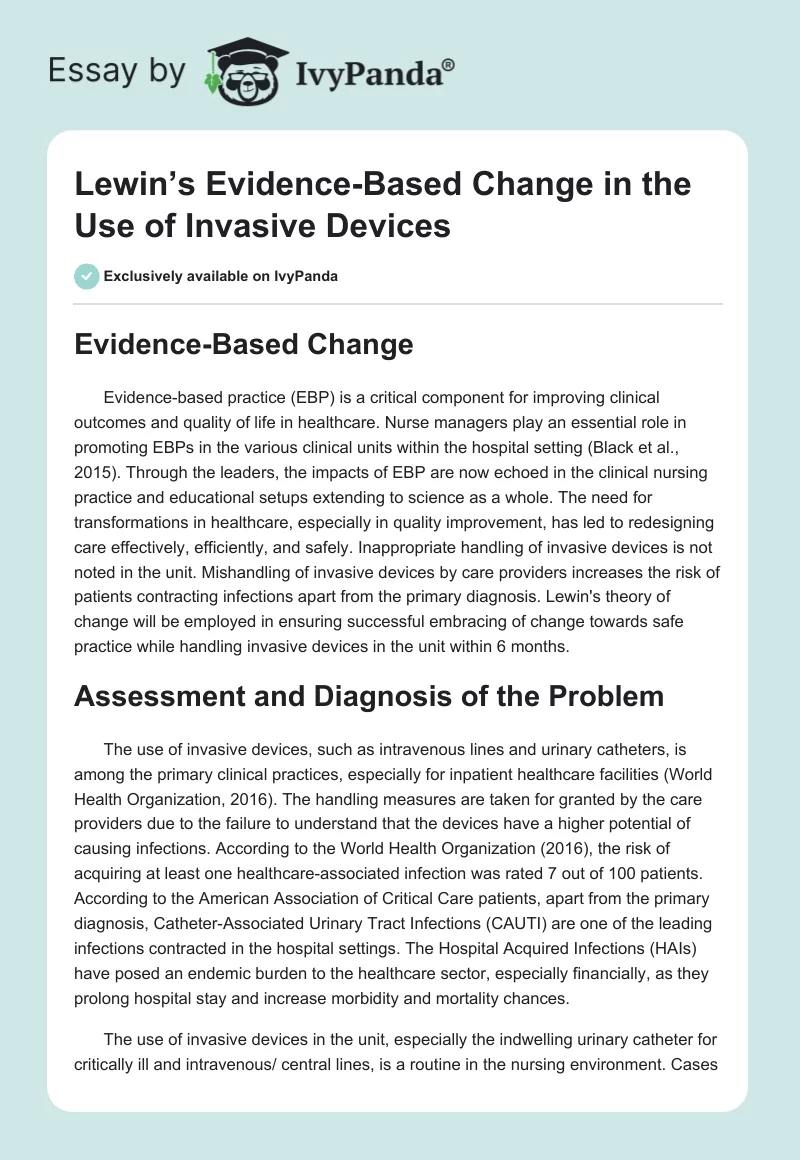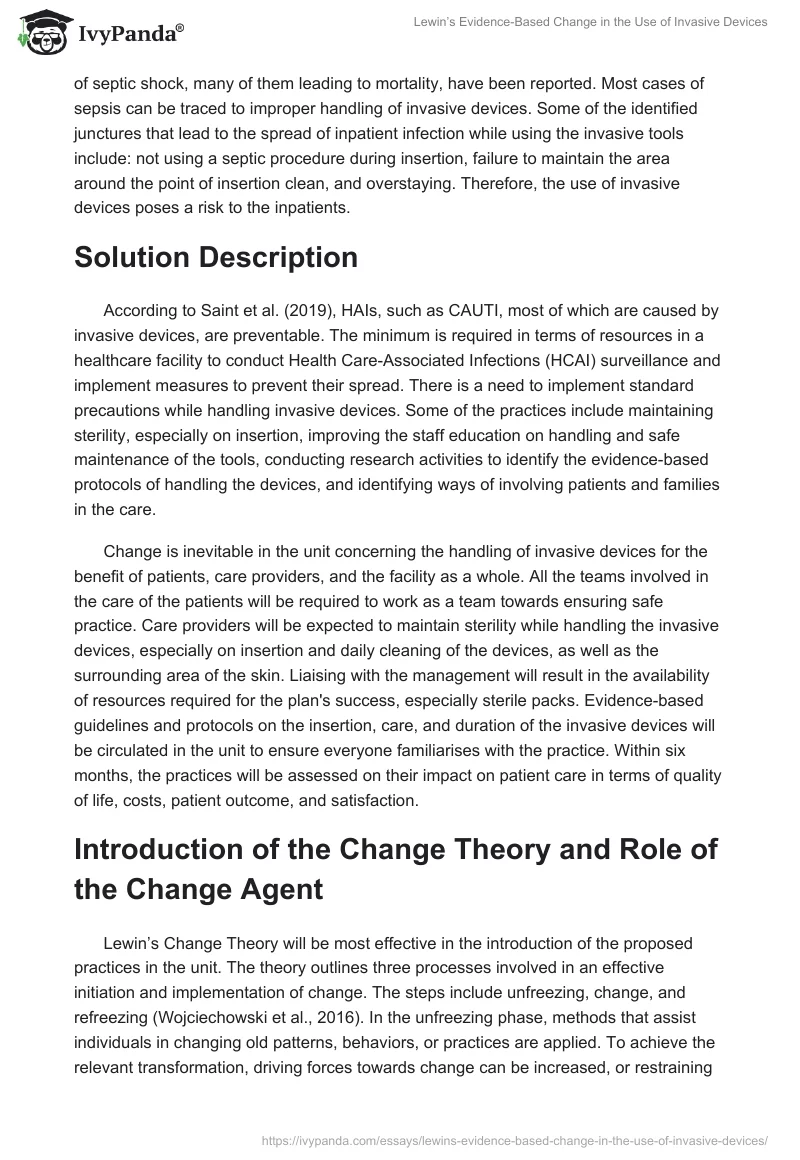- Evidence-Based Change
- Assessment and Diagnosis of the Problem
- Solution Description
- Introduction of the Change Theory and Role of the Change Agent
- Proposal of a Detailed Plan on How to Implement Change Including Timeline
- Criteria to Evaluate the Effectiveness of the Plan Including Timeline
- Reflection
- References
Evidence-Based Change
Evidence-based practice (EBP) is a critical component for improving clinical outcomes and quality of life in healthcare. Nurse managers play an essential role in promoting EBPs in the various clinical units within the hospital setting (Black et al., 2015). Through the leaders, the impacts of EBP are now echoed in the clinical nursing practice and educational setups extending to science as a whole.
The need for transformations in healthcare, especially in quality improvement, has led to redesigning care effectively, efficiently, and safely. Inappropriate handling of invasive devices is not noted in the unit. Mishandling of invasive devices by care providers increases the risk of patients contracting infections apart from the primary diagnosis. Lewin’s theory of change will be employed in ensuring successful embracing of change towards safe practice while handling invasive devices in the unit within 6 months.
Assessment and Diagnosis of the Problem
The use of invasive devices, such as intravenous lines and urinary catheters, is among the primary clinical practices, especially for inpatient healthcare facilities (World Health Organization, 2016). The handling measures are taken for granted by the care providers due to the failure to understand that the devices have a higher potential of causing infections. According to the World Health Organization (2016), the risk of acquiring at least one healthcare-associated infection was rated 7 out of 100 patients.
According to the American Association of Critical Care patients, apart from the primary diagnosis, Catheter-Associated Urinary Tract Infections (CAUTI) are one of the leading infections contracted in the hospital settings. The Hospital Acquired Infections (HAIs) have posed an endemic burden to the healthcare sector, especially financially, as they prolong hospital stay and increase morbidity and mortality chances.
The use of invasive devices in the unit, especially the indwelling urinary catheter for critically ill and intravenous/ central lines, is a routine in the nursing environment. Cases of septic shock, many of them leading to mortality, have been reported. Most cases of sepsis can be traced to improper handling of invasive devices. Some of the identified junctures that lead to the spread of inpatient infection while using the invasive tools include: not using a septic procedure during insertion, failure to maintain the area around the point of insertion clean, and overstaying. Therefore, the use of invasive devices poses a risk to the inpatients.
Solution Description
According to Saint et al. (2019), HAIs, such as CAUTI, most of which are caused by invasive devices, are preventable. The minimum is required in terms of resources in a healthcare facility to conduct Health Care-Associated Infections (HCAI) surveillance and implement measures to prevent their spread. There is a need to implement standard precautions while handling invasive devices. Some of the practices include maintaining sterility, especially on insertion, improving the staff education on handling and safe maintenance of the tools, conducting research activities to identify the evidence-based protocols of handling the devices, and identifying ways of involving patients and families in the care.
Change is inevitable in the unit concerning the handling of invasive devices for the benefit of patients, care providers, and the facility as a whole. All the teams involved in the care of the patients will be required to work as a team towards ensuring safe practice. Care providers will be expected to maintain sterility while handling the invasive devices, especially on insertion and daily cleaning of the devices, as well as the surrounding area of the skin. Liaising with the management will result in the availability of resources required for the plan’s success, especially sterile packs.
Evidence-based guidelines and protocols on the insertion, care, and duration of the invasive devices will be circulated in the unit to ensure everyone familiarises with the practice. Within six months, the practices will be assessed on their impact on patient care in terms of quality of life, costs, patient outcome, and satisfaction.
Introduction of the Change Theory and Role of the Change Agent
Lewin’s Change Theory will be most effective in the introduction of the proposed practices in the unit. The theory outlines three processes involved in an effective initiation and implementation of change. The steps include unfreezing, change, and refreezing (Wojciechowski et al., 2016). In the unfreezing phase, methods that assist individuals in changing old patterns, behaviors, or practices are applied. To achieve the relevant transformation, driving forces towards change can be increased, or restraining forces can be decreased.
Alternatively, both perspectives can be considered to realize the desired change. After unfreezing, individuals are introduced to the new practices, as well as their implications to thoughts, feelings, and behavior. In the last phase – refreezing, individuals are accustomed to the latest practices and incorporate them into the standard procedures.
The change agent plays a critical role in ensuring a smooth transition into the new practices. The in-charge presents research-based discourse outlining the need for change. The change agent also presents an initial proposal providing details and protocol concerning the new set of practices to achieve the documented goals. The in-charge also ensures the facilitation of resources from administrative individuals. The personnel coordinate activities about the expected change, ensuring all teams work in harmony to achieve organizational goals within the set time. Lastly, the change agent ensures the group’s challenges are identified and solved in time to eliminate barriers, which may cause a delay in the change process and progress.
Proposal of a Detailed Plan on How to Implement Change Including Timeline
Similar to Lewin’s theory, the process of adoption of new changes in the proposed area of practice will follow three phases. In the unfreezing phase, the staff will be given an allowance to unlearn the old practices. This will be achieved by understanding the negative impacts the practice has on patients receiving their care in the unit. Within one a month, resources with information on the unsafe practices will be circulating in all platforms within the unit.
In the following two months, the staff will undergo training on recommended safe practices while handling invasive devices. The training will go hand in hand with actual practice in the clinical setting.
External experts and clinical leaders will be spearheading the exercises to ensure staff are comfortable, have required resources, and work as a team to implement new practices.
In the next three months, the staff will be given a chance to exercise practices with minimal supervision. This is to allow the practices to be made part of the unit culture of practice. Individuals at the managerial level will be involved in ensuring the required resources are available to implement new practices. They will also ensure the new practices are integrated into the organizational policies that govern clinical practice in the unit and the whole facility.
The head of departments will also play a vital role in reinforcing the practices at the departmental level. Skills, such as effective communication skills and teamwork, will be used at the maximum for the successful implementation of change. The infection prevention team in the unit will be expected to follow up on the progress of new practices and be giving monthly updates to enable adjustments and decisions to be made in the way.
Criteria to Evaluate the Effectiveness of the Plan Including Timeline
Feedback from various points of care will be used to determine how the change of practices has impacted patient care, including cost, quality of life, hospital stay, patient outcome, and satisfaction. All individuals involved in the care of patients will be involved in the evaluation process. The length of the hospital stay will be identified and compared with the previous cases. The feedback from the patients will be used to determine how evidence-based practices impacted them. The care providers will be required to give feedback on how new rules have affected care quality and patient outcomes. The administration will determine how new practices have impacted costs. Tools, primarily questionnaires, will be employed in the evaluation exercise.
Reflection
All standards of practice contribute to the growth of knowledge, judgment skills, and attitude toward safety and quality approaches required in the field. The new conduct reflects desired and achievable performance levels, which can be used as a reference for actual performance. Therefore, the introduction of change in the health care professional guides the corresponding practices. A successful implementation of safe practices while handling invasive devices will improve nursing practice and contribute to research growth through knowledge, skills, judgment, and changed attitudes among those working in the profession. The safe practices will be adopted by new nursing practitioners, making it a culture in the profession. In the long run, nursing practice will be safe and effective, contributing to reduced hospital stay periods and costs, as well as improved quality of life, patient outcome, and satisfaction.
References
Black, A., Balneaves, L., Garossino, C., Puyat, J., & Qian, H. (2015). Promoting evidence-based practice through a research training program for point-of-care clinicians.JONA: The Journal of Nursing Administration, 45(1), 14-20. Web.
Saint, S., Meddings, J., Fowler, K., Vaughn, V., Ameling, J., & Rohde, & Chopra, V (2019). The Guide to Patient Safety for Health Care–Associated Infections. Annals of Internal Medicine, 171(7_Supplement), S7. Web.
Wojciechowski, E., Pearsall, T., Murphy, P., & French, E. (2016). A case review: Integrating Lewin’s theory with lean’s system approach for change. Online Journal of Issues in Nursing, 21(2).
World Health Organization. (2016). Healthcare-associated infections fact sheet [Ebook]. Web.


